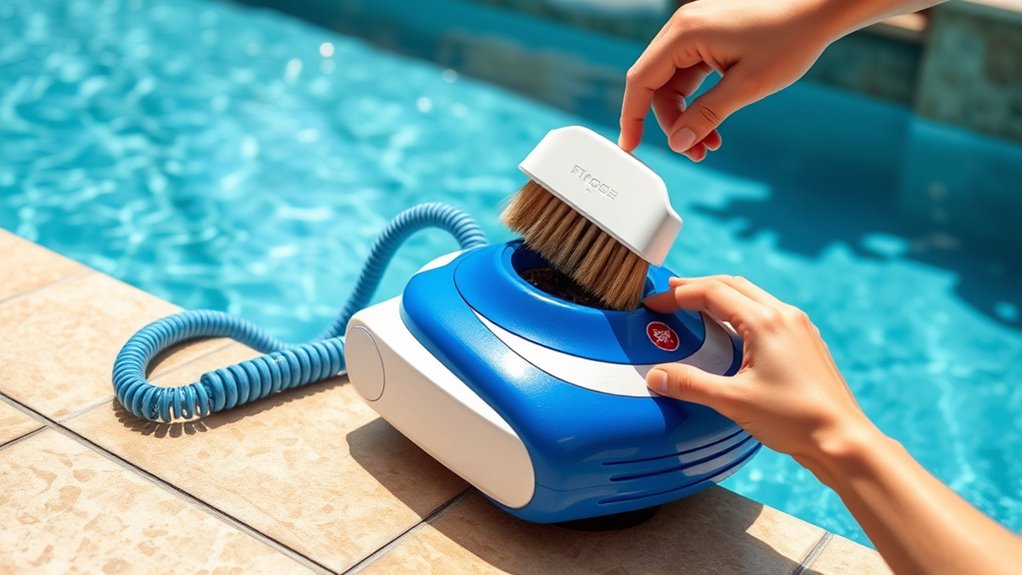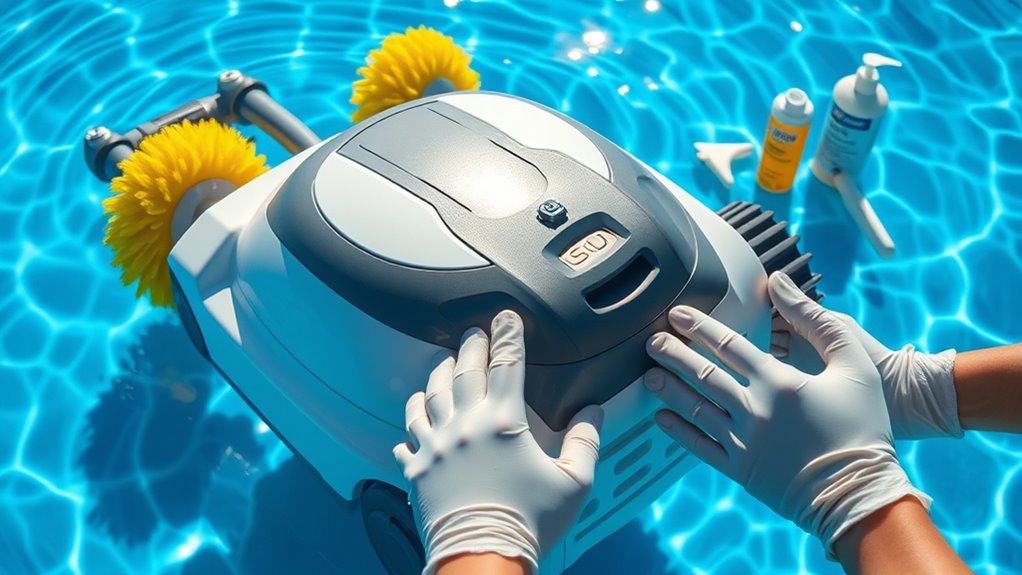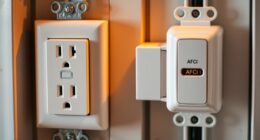To maintain your pressure pool cleaner, regularly check and clean the filter bag, emptying and rinsing it as needed to guarantee proper water flow. Make sure hose connections are secure and inspect for cracks or wear, replacing damaged sections. Keep all parts free of debris and lubricate moving components following manufacturer instructions. Store the cleaner properly during off-seasons and monitor its performance to catch wear early. Keep these tips in mind to help your cleaner work efficiently all season—more tips await if you continue.
Key Takeaways
- Regularly check and clean the filter bag to ensure optimal water flow and prevent motor strain.
- Secure all hose connections tightly and inspect for cracks or wear to prevent leaks and pressure loss.
- Rinse hoses and components frequently to remove debris and prevent blockages.
- Monitor the cleaner’s performance and address signs of wear or damage promptly.
- Store the cleaner properly in a dry, protected area during the off-season to maintain its condition.

Keeping your pressure pool cleaner in top shape is essential for ensuring it works efficiently all season long. One of the first steps is regularly inspecting and maintaining its filter bag. The filter bag traps debris, dirt, and leaves, preventing them from clogging the internal mechanisms and reducing the cleaner’s performance. Make it a habit to check the filter bag at least once a week, especially during heavy use or after storms. If the bag appears full or dirty, remove it carefully, empty the contents, and rinse it with a hose to clear out any stubborn debris. A clean filter bag allows for better water flow, which translates into more effective cleaning of your pool’s surfaces. Neglecting this step can cause strain on the cleaner’s motor and lead to subpar cleaning results.
Equally important is ensuring the hose connection is secure and in good condition. The hose connects your pressure cleaner to the pump, and a loose or damaged connection can cause leaks, loss of pressure, or even disconnection during operation. Before starting each cleaning session, double-check that the hose is firmly attached to both the cleaner and the intake or outlet port. Look for any cracks or wear along the hose, and replace sections if you notice any damage. A secure hose connection maintains ideal pressure, allowing the cleaner to move smoothly across the pool floor and walls. If you experience inconsistent movement or poor cleaning performance, re-examining the hose connection should be one of your first troubleshooting steps.
In addition to these checks, it’s wise to keep all components clean and free of debris. Rinse the hose and other parts with water regularly to prevent buildup that can hinder movement or cause blockages. Lubricate moving parts if recommended by the manufacturer, and always follow the specific maintenance instructions provided in your cleaner’s manual. During the season, periodically inspect the cleaner for signs of wear or damage, and address issues promptly. This proactive approach helps avoid costly repairs and extends the lifespan of your pressure pool cleaner. Regularly checking for filtration efficiency ensures your cleaner performs optimally and prolongs its durability. Moreover, staying informed about AI safety developments can help you understand how emerging technologies might influence pool equipment safety standards in the future. Additionally, understanding proper maintenance techniques can significantly reduce downtime and repair costs over time. Proper storage practices during the off-season can also prevent damage and keep your cleaner ready for use when needed.
Frequently Asked Questions
How Often Should I Replace the Pressure Pool Cleaner’s Hoses?
You might wonder about hose replacement for your pressure pool cleaner. Typically, hoses should be replaced when they show signs of wear, cracks, or leaks. Regular inspection helps you estimate the lifespan of your hoses, which is usually around 1-3 years depending on usage and conditions. Keep an eye on them, and don’t hesitate to replace hoses promptly to guarantee peak cleaner performance and prevent damage to your pool equipment.
Can I Use Household Cleaners to Clean the Pressure Cleaner?
You shouldn’t use household cleaners on your pressure cleaner because of household cleaner safety concerns and pressure cleaner compatibility issues. Many household cleaners contain chemicals that can damage or corrode the parts of your pressure pool cleaner. Instead, opt for manufacturer-recommended cleaning solutions or just use plain water and a soft brush. This approach keeps your cleaner working efficiently and avoids costly repairs due to incompatible cleaning agents.
What Signs Indicate My Pressure Pool Cleaner Needs Repairs?
A stitch in time saves nine, so watch for signs your pressure pool cleaner needs repairs. If you notice common wear on brushes or tracks, it’s time to inspect further. Unusual noises or inconsistent movement often point to motor failure. Don’t ignore reduced suction or debris left behind, as these indicate parts may be worn or damaged. Addressing issues early keeps your cleaner running smoothly and extends its lifespan.
Is It Safe to Leave the Cleaner in the Pool Overnight?
Leaving your pressure pool cleaner in the pool overnight is generally safe if it’s in good condition and properly maintained. For pool safety, make sure it’s unplugged or disconnected from power sources to prevent any electrical hazards. Overnight usage is convenient, but check for any leaks or damage beforehand. Regularly inspect the hoses and connections, and remove the cleaner if you notice issues. This helps keep your pool safe and your equipment working efficiently.
How Do I Troubleshoot if the Cleaner Isn’t Moving Properly?
Think of your pool cleaner as a diligent dancer in a grand performance, needing the right rhythm to move gracefully. If it stalls, start troubleshooting by checking for tangled hoses, debris blocking the intake, or worn brushes. Make sure the filters are clean, and the pressure is correct. Regular pool cleaner maintenance and troubleshooting tips keep the dance smooth, preventing hiccups and ensuring your cleaner glides effortlessly across the pool’s surface.
Conclusion
By staying on top of maintenance, you’ll keep your pressure pool cleaner running like a well-oiled machine—almost unstoppable! Regularly check the hoses, clean the filters, and monitor the pressure levels to prevent any hiccups. Think of it as giving your cleaner a daily tune-up, ensuring it’s always ready to conquer dirt and debris. With a little effort, your pool will stay crystal clear and inviting, turning your backyard into a paradise that shines brighter than the sun!










